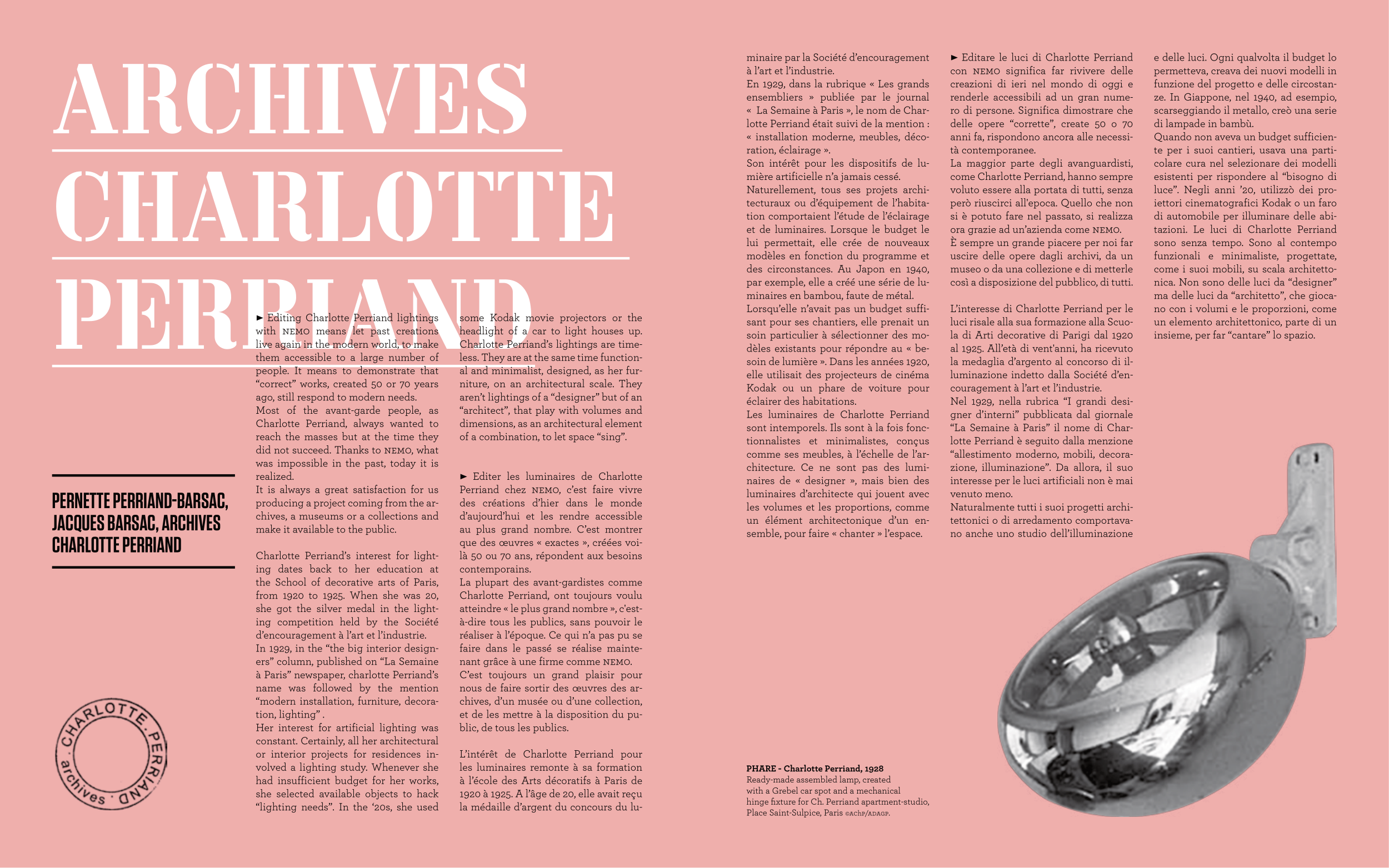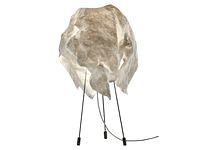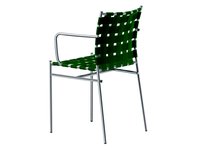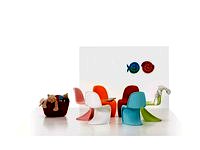minaire par la Société d’encouragement
à l’art et l’industrie.
En 1929, dans la rubrique « Les grands
ensembliers » publiée par le journal
« La Semaine à Paris », le nom de Char-
lotte Perriand était suivi de la mention :
« installation moderne, meubles, déco-
ration, éclairage ».
Son intérêt pour les dispositifs de lu-
mière artificielle n’a jamais cessé.
Naturellement, tous ses projets archi-
tecturaux ou d’équipement de l’habita-
tion comportaient l’étude de l’éclairage
et de luminaires. Lorsque le budget le
lui permettait, elle crée de nouveaux
modèles en fonction du programme et
des circonstances. Au Japon en 1940,
par exemple, elle a créé une série de lu-
minaires en bambou, faute de métal.
Lorsqu’elle n’avait pas un budget suffi-
sant pour ses chantiers, elle prenait un
soin particulier à sélectionner des mo-
dèles existants pour répondre au « be-
soin de lumière ». Dans les années 1920,
elle utilisait des projecteurs de cinéma
Kodak ou un phare de voiture pour
éclairer des habitations.
Les luminaires de Charlotte Perriand
sont intemporels. Ils sont à la fois fonc-
tionnalistes et minimalistes, conçus
comme ses meubles, à l’échelle de l’ar-
chitecture. Ce ne sont pas des lumi-
naires de « designer », mais bien des
luminaires d’architecte qui jouent avec
les volumes et les proportions, comme
un élément architectonique d’un en-
semble, pour faire « chanter » l’espace.
► Editare le luci di Charlotte Perriand
con nemo significa far rivivere delle
creazioni di ieri nel mondo di oggi e
renderle accessibili ad un gran nume-
ro di persone. Significa dimostrare che
delle opere “corrette”, create 50 o 70
anni fa, rispondono ancora alle necessi-
tà contemporanee.
La maggior parte degli avanguardisti,
come Charlotte Perriand, hanno sempre
voluto essere alla portata di tutti, senza
però riuscirci all'epoca. Quello che non
si è potuto fare nel passato, si realizza
ora grazie ad un’azienda come nemo.
È sempre un grande piacere per noi far
uscire delle opere dagli archivi, da un
museo o da una collezione e di metterle
così a disposizione del pubblico, di tutti.
L’interesse di Charlotte Perriand per le
luci risale alla sua formazione alla Scuo-
la di Arti decorative di Parigi dal 1920
al 1925. All’età di vent'anni, ha ricevuto
la medaglia d’argento al concorso di il-
luminazione indetto dalla Société d’en-
couragement à l’art et l’industrie.
Nel 1929, nella rubrica “I grandi desi-
gner d’interni” pubblicata dal giornale
“La Semaine à Paris” il nome di Char-
lotte Perriand è seguito dalla menzione
“allestimento moderno, mobili, decora-
zione, illuminazione”. Da allora, il suo
interesse per le luci artificiali non è mai
venuto meno.
Naturalmente tutti i suoi progetti archi-
tettonici o di arredamento comportava-
no anche uno studio dell’illuminazione
e delle luci. Ogni qualvolta il budget lo
permetteva, creava dei nuovi modelli in
funzione del progetto e delle circostan-
ze. In Giappone, nel 1940, ad esempio,
scarseggiando il metallo, creò una serie
di lampade in bambù.
Quando non aveva un budget sufficien-
te per i suoi cantieri, usava una parti-
colare cura nel selezionare dei modelli
esistenti per rispondere al “bisogno di
luce”. Negli anni ’20, utilizzò dei pro-
iettori cinematografici Kodak o un faro
di automobile per illuminare delle abi-
tazioni. Le luci di Charlotte Perriand
sono senza tempo. Sono al contempo
funzionali e minimaliste, progettate,
come i suoi mobili, su scala architetto-
nica. Non sono delle luci da “designer”
ma delle luci da “architetto”, che gioca-
no con i volumi e le proporzioni, come
un elemento architettonico, parte di un
insieme, per far “cantare” lo spazio.
ARCHIVES
CHARLOTTE
PERRIAND
► Editing Charlotte Perriand lightings
with nemo means let past creations
live again in the modern world, to make
them accessible to a large number of
people. It means to demonstrate that
“correct” works, created 50 or 70 years
ago, still respond to modern needs.
Most of the avant-garde people, as
Charlotte Perriand, always wanted to
reach the masses but at the time they
did not succeed. Thanks to nemo, what
was impossible in the past, today it is
realized.
It is always a great satisfaction for us
producing a project coming from the ar-
chives, a museums or a collections and
make it available to the public.
Charlotte Perriand’s interest for light-
ing dates back to her education at
the School of decorative arts of Paris,
from 1920 to 1925. When she was 20,
she got the silver medal in the light-
ing competition held by the Société
d’encouragement à l’art et l’industrie.
In 1929, in the “the big interior design-
ers” column, published on “La Semaine
à Paris” newspaper, charlotte Perriand’s
name was followed by the mention
“modern installation, furniture, decora-
tion, lighting” .
Her interest for artificial lighting was
constant. Certainly, all her architectural
or interior projects for residences in-
volved a lighting study. Whenever she
had insufficient budget for her works,
she selected available objects to hack
“lighting needs”. In the ‘20s, she used
some Kodak movie projectors or the
headlight of a car to light houses up.
Charlotte Perriand’s lightings are time-
less. They are at the same time function-
al and minimalist, designed, as her fur-
niture, on an architectural scale. They
aren’t lightings of a “designer” but of an
“architect”, that play with volumes and
dimensions, as an architectural element
of a combination, to let space “sing”.
► Editer les luminaires de Charlotte
Perriand chez nemo, c’est faire vivre
des créations d’hier dans le monde
d’aujourd’hui et les rendre accessible
au plus grand nombre. C’est montrer
que des œuvres « exactes », créées voi-
là 50 ou 70 ans, répondent aux besoins
contemporains.
La plupart des avant-gardistes comme
Charlotte Perriand, ont toujours voulu
atteindre « le plus grand nombre », c'est-
à-dire tous les publics, sans pouvoir le
réaliser à l’époque. Ce qui n’a pas pu se
faire dans le passé se réalise mainte-
nant grâce à une firme comme nemo.
C’est toujours un grand plaisir pour
nous de faire sortir des œuvres des ar-
chives, d’un musée ou d’une collection,
et de les mettre à la disposition du pu-
blic, de tous les publics.
L’intérêt de Charlotte Perriand pour
les luminaires remonte à sa formation
à l’école des Arts décoratifs à Paris de
1920 à 1925. A l’âge de 20, elle avait reçu
la médaille d’argent du concours du lu-
PERNETTE PERRIAND-BARSAC,
JACQUES BARSAC, ARCHIVES
CHARLOTTE PERRIAND
PHARE - Charlotte Perriand, 1928
Ready-made assembled lamp, created
with a Grebel car spot and a mechanical
hinge fixture for Ch. Perriand apartment-studio,
Place Saint-Sulpice, Paris ©achp/adagp.







